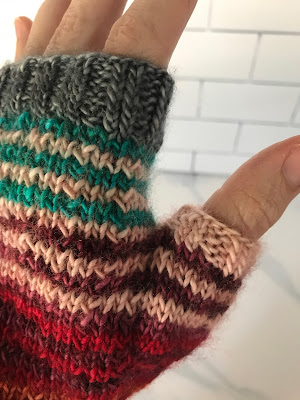Saturday, July 31, 2021
Batch of links
Friday, July 30, 2021
Turkey Bolognese
This recipe is from The 30-minute Prediabetes Cookbook by Ranelle Kirchner. I’m enjoying all the information in here, and also the philosophy that the goal isn’t to eat zero-carb meals, just lower-carb. (The author also distinguishes between simple and complex carbs, which makes sense to me, even though my endocrinologist was warning against any kind of carb.)
Thursday, July 29, 2021
Carrot and Red Lentil Soup
I hadn’t posted about this carrot and red lentil soup yet, perhaps because I already have recipes here along the same lines, but looking back, I realize that it was the best soup I’d made in a long time. I had tried a few new soup recipes in the spring, like a bacon-potato soup with cheddar and chives (it was too watery, and based on reviews, others felt the same!), and also a tomato pasta soup that I made by combining the best part of two recipes (Bon Appétit’s low broth-to-fillings ratio and Ricardo’s pasta coated in turmeric oil), but it was just okay. And then I made the carrot soup and all was right with the world again.
Wednesday, July 28, 2021
Citrus Chickpea Almond Muffins
As I was digging through my recipes to find a make-ahead breakfast dish that was low in sugar, I found these lemon chickpea muffins. I’ve decided to call them citrus muffins, given that there’s as much orange flavor as lemon! I’ve also decided that the aquafaba should be kept and whipped, then added in with the whipped egg whites. These muffins were good, though I’ll admit that I don’t like them as much as “regular” muffins. Also, since there’s not much sugar in them, they don’t keep long – I recommend keeping them in the fridge or freezing them.
Monday, July 26, 2021
Stuffed Peppers
I tried making these stuffed tomatoes with lemon and garlic where, instead of rice, you used riced cauliflower. (I didn’t use the brand of flavored riced cauliflower that was recommended, because it contains lactose, so I had plain riced cauliflower that I flavored myself with lemon zest, garlic, salt and pepper.) And the truth is, I’m really not a big fan of riced cauliflower. So I decided to make the classic stuffed peppers, with a recipe that didn’t call for too much rice. I used this one, and it was delicious!
Friday, July 23, 2021
Vanilla-Pecan Coffee Cake
I pulled out Joanne Chang’s Baking With Less Sugar again and took a look at the recipes I had flagged but hadn’t made yet. I zeroed in on the vanilla-pecan coffee cake, which she adapted from her bakery’s famous sour cream coffee cake. The cake itself has less sugar than the original version, and the streusel uses honey (still a sweetener, but one with a lower glycemic index).
Saturday, July 17, 2021
Taco Bowl
I got this recipe in a batch of free downloads from The Hormone Dietitian. It was originally a breakfast bowl, but I’m not yet into vegetables for breakfast; for me, this was a delicious lunch, though! What drew me to this recipe originally was that I wanted something low in carbs and high in protein, but you don’t need to be on a special diet to eat this. (If you want something that’s also TexMex-inspired for a family meal, you could always make these chicken and bell pepper fajitas and… omit the tortillas? Or at least serve components separately and let people who want tortillas have some, while you load up on vegetables?)
Saturday, July 10, 2021
Wrist warmers and a cowl
At some point last year, I decided to splurge and bought myself this kit to make wrist warmers. (It was a splurge insofar as I don’t normally drop that much money on a knitting project, but it was well within my self-imposed annual knitting budget.) The kit contained a pattern by Vickie Howell and 5 skeins of Madelinetosh Tosh Merino Light yarn in colors that she had designed (gray, turquoise, orange, purple, and pink); the color pairing just made me so happy! They were actually out of the Nassau Blue (turquoise) yarn, so I used the Nassau Blue Tweed yarn instead. And because I like red more than orange and just couldn’t help myself, I threw in a skein of red, actually called Blood Runs Cold. And then I downloaded the (free!) cowl pattern that had been in the back of my mind for a while, Inspira (which I had first seen in these colors). I love that it comes in three different patterns, based on the size of your yarn!
Friday, July 09, 2021
Marzipan Buckeye Bars
I made this chocolate almond tart from Famille futée 3 not once, but twice. It’s a recipe that, according to the headnote, “only calls for 5 ingredients, one of which is chocolate. Case closed.” The first time, I used natural almond butter, but the crust fell apart and the chocolate part was too hard. The second time, I used creamy peanut butter, which the headnote said would make the dessert taste like a giant Reese’s. It didn’t! It was better, but it still had all the problems of the original to some extent, and it really wasn’t as good as it looked.
Thursday, July 08, 2021
PCOS and stuff
[This is another rambling, personal post about health and, while it may seem specific to me, enough women suffer from PCOS (anywhere between 1 in 10 and 1 in 4, depending on the source) that it could be relevant to others as well. As always, feel free to skip it and wait for the next recipe!]
Tuesday, July 06, 2021
Mafé de poulet sénégalais
J’ai fait cette recette tirée de Famille futée 3. Je n’avais jamais mangé de mafé de poulet auparavant, et je ne peux bien sûr pas dire que cette recette soit authentique, mais nous avons beaucoup aimé! J’ai servi le plat avec du riz, mais on pourrait aussi servir avec du pain ou des légumes. J’avais utilisé un peu plus de poulet un peu pour nous faire des restes.


















































